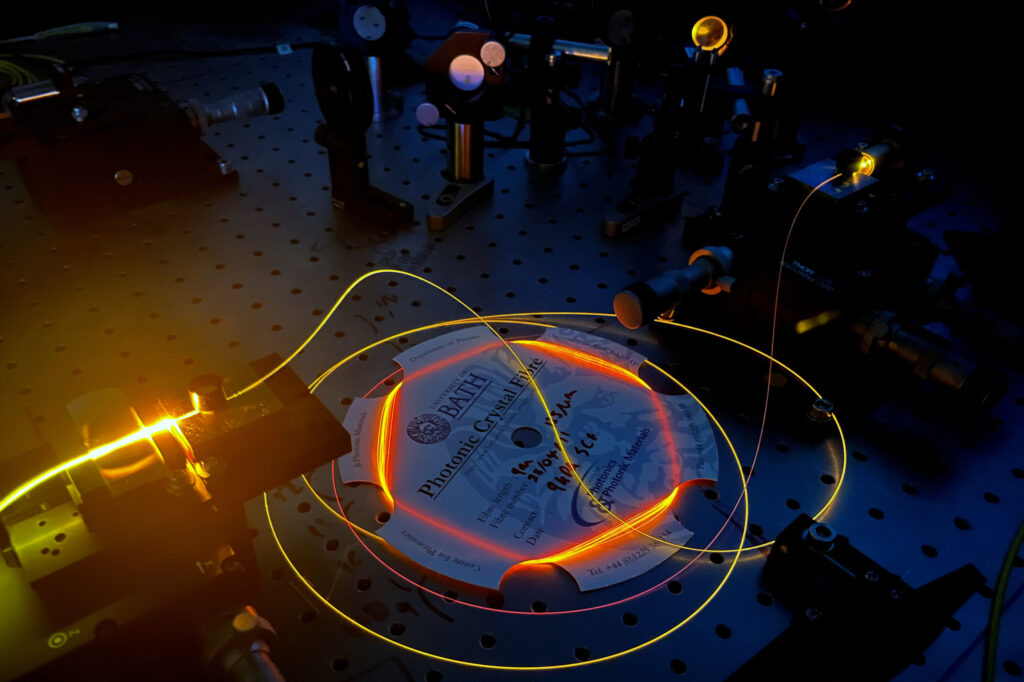Bright light is guided through optical fibres manufactured at the University of Bath. Photo credit: Cameron McCurry, University of Bath
Physicists at the University of Bath in the UK have developed a new generation of specialised optical fibres to tackle the data transmission challenges expected to arise in the future era of quantum computing.
Quantum technology promises to provide unparalleled computing power to solve complex logical problems, develop new medicines, and provide unbreakable encryption techniques for secure communications. However, the cable networks currently used to transmit information around the world may not be ideal for quantum communication due to the solid core of optical fibers.
Unlike ordinary optical fibre, the speciality optical fibre manufactured at Bath has a microstructured core made up of an intricate pattern of air pockets that run the entire length of the fibre.
“Traditional optical fibres, the workhorse of today’s communications networks, transmit light at wavelengths that are entirely dominated by the losses in silica glass. However, these wavelengths are incompatible with the operating wavelengths of the single-photon sources, qubits and active optical components needed for light-based quantum technologies,” said Dr Kristina Rusimova from the University of Bath’s School of Physics.
In their academic paper published in Applied Physics Letters Quantum, Dr Roussimova and her colleagues describe the cutting-edge fibre manufactured in Bath, as well as other recent and future developments in the emerging field of quantum computing.
Dr Rusimova, lead author of the paper, added: “The design and manufacture of optical fibres is at the forefront of research at the School of Physics at the University of Bath and developing optical fibres with quantum computing in mind lays the foundations for future data transmission needs.”
Quantum entanglement
Light is a promising medium for quantum computing: individual particles of light, called photons, have unique quantum properties that can be exploited in quantum technologies.
One example is quantum entanglement, where two far-flung photons not only retain information about each other but can also affect each other’s properties instantaneously. Unlike the binary bits (1 or 0) of a classical computer, an entangled pair of photons can actually exist as both 1 and 0 simultaneously, unlocking enormous computational power.
“A quantum internet is an essential element in realising the vast potential of these emerging quantum technologies,” said Dr Cameron McCurry, until recently a physicist at the University of Bath and lead author of the paper.
“Like the existing internet, the quantum internet will rely on optical fibres to deliver information from node to node. These optical fibres will likely be very different from those used today and will require different supporting technologies to be useful.”
The researchers discuss the challenges associated with the quantum internet from the perspective of fiber optics technology and present various potential solutions to achieve robust, large-scale quantum network scalability.
This includes both the fibre used for long distance communications, and specialised fibre to enable quantum repeaters to be integrated directly into networks to extend the distances over which this technology can operate.
Beyond connecting nodes
We also describe how specialized optical fibers not only connect the nodes of a network, but also implement quantum computing at the nodes themselves by acting as sources of entangled single photons, quantum wavelength converters, low-loss switches, or containers for quantum memory.
Dr McCurley said: “Unlike standard optical fibres used for communications, the speciality optical fibres routinely manufactured in Bath have a microstructured core made up of an intricate pattern of air pockets that run the entire length of the fibre.”
“These patterns of air pockets allow researchers to manipulate the properties of light inside the fiber, creating entangled pairs of photons, changing the color of photons, and even trapping individual atoms inside the fiber.”
“Researchers around the world are making rapid and exciting advances in the capabilities of microstructured optical fibers in ways that are of interest to industry,” said Dr. Kerriann Harrington, a postdoctoral researcher in the Department of Physics.
“From our perspective, it’s an exciting advancement in these new fibers and how they could potentially benefit future quantum technologies.”
Dr Alex Davies, EPSRC Quantum Carrier Acceleration Fellow at the University of Bath, added: “It is fibre’s ability to tightly confine light and transmit it over long distances that makes it so useful.”
“This makes it possible not only to generate entangled photons but also to generate more exotic quantum states of light for applications such as quantum computing, precision sensing and impenetrable message encryption.”
Quantum advantage – the ability of quantum devices to perform tasks more efficiently than classical computers – has yet to be conclusively demonstrated. The technical challenges identified in this Perspective are likely to open new avenues for quantum research and bring us closer to achieving this important milestone. The optical fibre manufactured in Bath is expected to help lay the foundations for future quantum computers.
Bath’s research team included senior lecturer Dr Peter Moseley;
Further information: Cameron McGarry et al., “Microstructured Optical Fibers for Quantum Applications: A Perspective.” APL Quantum (2024). DOI: 10.1063/5.0211055
Provided by University of Bath
Source: Optical Fibers for the Quantum Computing Era (July 29, 2024) Retrieved July 29, 2024 from https://phys.org/news/2024-07-optical-fibers-age-quantum.html
This document is subject to copyright. It may not be reproduced without written permission, except for fair dealing for the purposes of personal study or research. The content is provided for informational purposes only.

